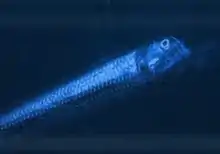Viperfish
A viperfish is any species of marine fish in the genus Chauliodus. Viperfish are characterized by long, needle-like teeth and hinged lower jaws. A typical viperfish grows to lengths of 30 to 60 cm (12 to 23.5 in). Viperfish stay near lower depths (250–5,000 feet [80–1,520 m]) in the daytime and shallower depths at night, primarily in tropical and temperate waters. Viperfish are believed to attack prey after luring them within range with light-producing organs called photophores, which are located along the ventral sides of its body, and with a prominent photophore at the end of a long spine in the dorsal fin reminiscent of the illicium of the unrelated deepsea anglerfishes. The viperfish flashes this natural light on and off, at the same time moving its dorsal spine around like a fishing rod and hanging completely still in the water. It also uses the light producing organ to communicate to potential mates and rivals.
- The name "viperfish" is also sometimes applied to the lesser weever.
| Viperfish | |
|---|---|
 | |
| Dana viperfish, Chauliodus danae | |
| Scientific classification | |
| Kingdom: | Animalia |
| Phylum: | Chordata |
| Class: | Actinopterygii |
| Order: | Stomiiformes |
| Family: | Stomiidae |
| Genus: | Chauliodus Bloch & J. G. Schneider, 1801 |
| Species | |
|
See text | |
Viperfish vary in color from green, silver, to black. A viperfish uses its fang-like teeth to immobilize prey and would not be able to close its mouth because of their length, if it were not able to fold and curve them behind its head. The first vertebra behind the head of the viperfish absorbs the shock of biting prey. As with other deepsea fish, they are able to endure long periods with minimal food.
Viperfish are believed to live from 30 to 40 years in the wild, but in captivity they rarely live more than a few hours. Some species of dolphins and sharks are known to prey upon viperfish. Scientists believe they can swim at a speed of two body lengths per second, but this is not yet an official speed.
Although it may appear to be covered in scales, it is covered by a thick, transparent coating of unknown substance.[2] Extremely large, fang-like teeth give the fish a slightly protruded lower jaw which makes catching prey easy. The viperfish is lined with three different types of photophores, which some speculate are used to lure prey. [2] They have microscopic spheres without a pigment layer that are scattered over the dorsal side, large spheres with a pigment coat, reflectors, and lens and large, bell-shaped organs with a pigment coat, reflectors, and lens that are grouped together in rows along the dorsal surface. Photophores can also be seen along the ventral and lateral surface of the fish.[3]
Habitat
Because viperfish live in bathypelagic environments inaccessible to humans, little is known about their habits. They are found from a depth of 1,000 to 4,000 meters with an average temperature of 4 degrees Celsius. Viperfish are thought to engage in a daily vertical migration, as they have been observed in the mesopelagic region at night, which lies directly above the bathypelagic region.[2] More direct observation is needed to confirm this assumption.
Feeding
Viperfish do not appear to have any preferred prey. Stomach contents of captured individuals have contained lanternfish, bristlemouthes and other fish, suggesting that they attack and swallow whatever random prey they encounter.[3] With their dark coloration, they can appear invisible and have been observed to remain motionless for hours ready to strike on unsuspecting prey.[4] Prey is captured and killed by being pierced by the viperfish's long teeth, and then swallowed whole. The photophores along the viperfish's belly are thought to help lure prey, though further observation is needed to confirm this hypothesis. The first vertebra, immediately behind the head, acts as a shock absorber. The viperfish uses this light organ to attract its prey through bioluminescence. By flashing the light on and off, it can be used like a fishing lure to attract smaller fish.
Species
There are currently nine extant recognized species in this genus:[5]
- Chauliodus barbatus Garman, 1899
- Chauliodus danae Regan & Trewavas, 1929 (Dana viperfish)
- Chauliodus dentatus Garman, 1899
- Chauliodus macouni T. H. Bean, 1890 (pacific viperfish)
- Chauliodus minimus Parin & Novikova, 1974
- Chauliodus pammelas Alcock, 1892
- Chauliodus schmidti Ege, 1948
- Chauliodus sloani Bloch & J. G. Schneider, 1801 (Sloane's viperfish)
- Chauliodus vasnetzovi Novikova, 1972
At least two more species are recognized from Late Miocene-aged fossils:
- Chauliodus eximus, (Jordan, 1925), originally Eostomias eximus, from Late Miocene California
- Chauliodus testa, Nazarkin, 2014, from the Late Miocene of Western Sakhalin Island[6]
See also
References
- Sepkoski, J. John Jr. (2002-09-16). Jablonski, David; Foote, Michael (eds.). "A compendium of fossil marine animal genera". Bulletins of American Paleontology (363): 5–560. ISBN 0877104506. ISSN 0007-5779. LCCN 2002108976. Retrieved 2018-02-15.
- Haffner, Rudolph E. (1952-09-01). "Zoogeography of the bathypelagic fish, Chauliodus". Systematic Zoology. 1 (3): 113–133. doi:10.1093/sysbio/1.3.113. ISSN 1063-5157.
- Butler, Mari; et al. (2001). "Mesopelagic fishes of the Arabian Sea: distribution, abundance and diet of Chauliodus pammelas, Chauliodus sloani, Stomias affinis, and Stomias nebulosus" (PDF). Deep-Sea Research Part II: Topical Studies in Oceanography. 48 (6–7): 1369–1383. doi:10.1016/S0967-0645(00)00143-0. ISSN 0967-0645.
- Deep Sea Creatures. “Viperfish” 2014. Web.
- Froese, Rainer and Pauly, Daniel, eds. (2012). Species of Chauliodus in FishBase. February 2012 version.
- M. V. Nazarkin (May 2014). "The fossil viperfish Chauliodus testa sp. nov. (Stomiiformes: Stomiidae) from the Neogene of western Sakhalin, Russia". Paleontological Journal. 48 (3): 317–325. doi:10.1134/S0031030114030150.